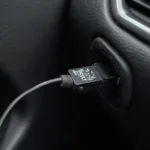When did OBD2 start? It’s a question that many car owners and mechanics ask. The implementation of OBD2, or On-Board Diagnostics II, represents a pivotal moment in automotive history. This article delves into the history of OBD2, exploring its origins, evolution, and global impact. when did obd2
The Origins of OBD2: Addressing Emissions Concerns
The story of OBD2 begins in the smoggy skies of California in the 1960s. Growing concerns about air pollution led the state to introduce early emissions regulations, pushing automakers to develop rudimentary diagnostic systems. These early systems, known as OBD, were the precursors to OBD2, focusing primarily on monitoring a limited number of emissions-related components.
The Clean Air Act and the Standardization of OBD2
In 1990, the US Congress amended the Clean Air Act, mandating the implementation of a standardized onboard diagnostic system for all light-duty vehicles sold in the United States. This standardized system, known as OBD2, aimed to improve air quality by ensuring consistent monitoring and reporting of emissions-related problems. The initial rollout of OBD2 began in 1994 for California and expanded to all other states by 1996. This landmark legislation effectively ushered in the era of standardized diagnostics, revolutionizing the way vehicles are serviced and maintained.
Key Features of OBD2: Enhanced Diagnostics and Standardization
OBD2 introduced several crucial improvements over its predecessor. These include a standardized diagnostic connector (the familiar 16-pin DLC), standardized diagnostic trouble codes (DTCs), and access to real-time data from the vehicle’s onboard computer. This standardization made it easier for mechanics to diagnose and repair emissions-related problems, regardless of the vehicle’s make or model.
How Did OBD2 Change the Automotive Landscape?
OBD2 transformed the automotive industry in several significant ways. It empowered car owners with more information about their vehicles, allowing them to understand and address potential issues proactively. It also streamlined the diagnostic process for mechanics, reducing repair times and costs.
When Did OBD2 Start in Different Regions?
While OBD2 originated in the United States, its influence quickly spread globally. Many countries adopted similar standards, often referred to as EOBD (European On-Board Diagnostics) or JOBD (Japanese On-Board Diagnostics). While these standards share many similarities with OBD2, there are also some regional variations. Understanding these differences is important for anyone working with vehicles from different parts of the world.
OBD2’s Impact on Vehicle Maintenance and Repair
The introduction of OBD2 significantly simplified vehicle maintenance and repair. By providing access to a wealth of diagnostic information, OBD2 allowed mechanics to identify and address problems quickly and efficiently. This, in turn, led to improved vehicle reliability and reduced emissions.
“OBD2 revolutionized the way we diagnose and repair vehicles,” says automotive expert David Miller. “It brought transparency and efficiency to the repair process, benefiting both mechanics and car owners.”
OBD2 Today and Beyond
OBD2 continues to evolve, with ongoing developments aimed at improving its capabilities and addressing emerging challenges. As vehicles become increasingly sophisticated, OBD2 is adapting to meet the demands of new technologies.
obd2 started in ford f150 in what yeae
The Future of OBD: What Lies Ahead?
The future of OBD likely involves greater integration with telematics and cloud-based diagnostics. This could enable remote diagnostics and predictive maintenance, further enhancing vehicle reliability and reducing downtime.
“The future of OBD is bright,” says automotive engineer Sarah Johnson. “We can expect to see even more sophisticated diagnostic capabilities, allowing us to anticipate and address potential problems before they even occur.”
Conclusion: OBD2’s Lasting Legacy
When did OBD2 start? As we have explored, its implementation, starting in 1994 for California and 1996 nationwide, marked a significant milestone in automotive history. From its humble beginnings as a basic emissions monitoring system, OBD2 has become an indispensable tool for vehicle maintenance and repair. Its impact extends far beyond emissions control, shaping the way we interact with our vehicles and revolutionizing the automotive industry. when did obd2 start in australia
FAQ
- What does OBD2 stand for?
OBD2 stands for On-Board Diagnostics II.
- Where is the OBD2 port located?
The OBD2 port is typically located under the dashboard on the driver’s side.
- What does an OBD2 scanner do?
An OBD2 scanner reads diagnostic trouble codes (DTCs) and other data from the vehicle’s onboard computer.
- Can I use any OBD2 scanner on my car?
Generally, yes, but some scanners may offer more advanced features or be better suited for specific vehicle makes and models.
- What are some common OBD2 codes?
P0300 (random misfire), P0420 (catalyst system efficiency below threshold), and P0171 (system too lean) are a few common examples.
- How often should I check my OBD2 system?
It’s a good idea to check your OBD2 system whenever you experience any unusual vehicle behavior or have your car serviced regularly.
- How do I clear OBD2 codes?
You can clear OBD2 codes using an OBD2 scanner or by disconnecting the vehicle’s battery. However, simply clearing codes without addressing the underlying issue will likely result in the codes returning.
Need support? Contact us via WhatsApp: +1(641)206-8880, Email: cardiagtechworkshop@gmail.com or visit us at 789 Elm Street, San Francisco, CA 94102, USA. We have a 24/7 customer support team.


